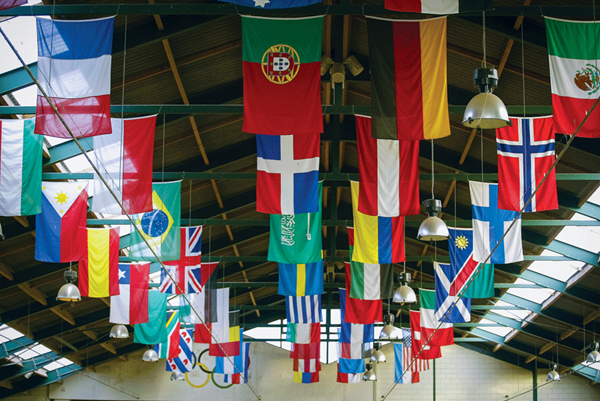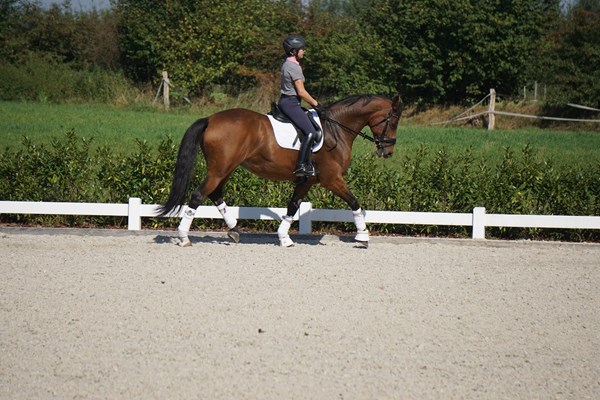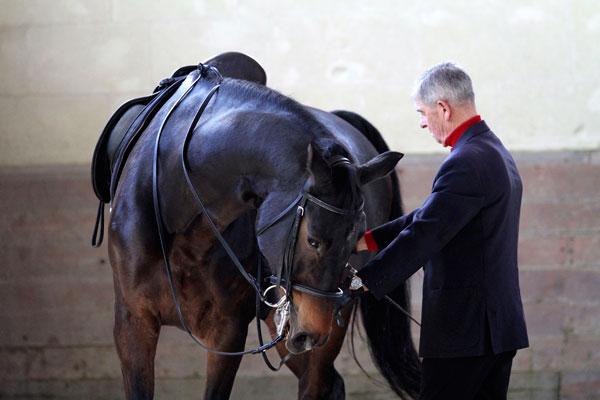Q: I’ll soon be in the market for a new dressage horse. I’ve noticed that the dollar has a lot more buying power in Europe. I was wondering if I should consider importing. What’s the dressage-horse market like in Europe now?— Jessica Bradley of Salt Lake City, Utah
A: Your decision will be driven to a great degree by what type of horse you’re in the market for. It may help if you understand what has happened to Western Europe’s sport-horse industry in the last decade.

Some of us remember the late 1990s and early 2000s, when shopping in Europe was a dressage-horse buyer’s dream. With strong buying power and abundant European inventory available, an amateur could shop in Holland, Germany, Belgium and Denmark for a few days and see a dozen or more Fourth Level amateur prospects between 10 and 12 years old, all priced less than the car the customer drove to the airport.
In the early 2000s it was common to run into other American buyers when shopping, particularly in Holland and northern Germany. At any given time, there were several buyers being escorted by European agents eager to build a lucrative business selling dressage horses to foreigners, especially Americans.
Sales stables were filled with horses like cars at a car dealership. Inventory turned over quickly, and importing companies were kept quite busy coordinating plane and quarantine schedules. While U.S. breeders argued that they were producing some quality stock stateside (and they were), they simply couldn’t compete with the inventory selection and “one-flight” shopping experience western Europe delivered.
The viability of Americans shopping in Europe was pretty much over in November 2007 when $1.49 bought €1. Only a few die-hards who didn’t care as much about price remained in the market. Americans pulling out of the European buying landscape was devastating for many horse dealers, especially the numerous professionals in Holland and northern Germany. While eastern European and Russian buying increased during those years, it wasn’t enough. Many professionals and breeders went out of business or scaled back considerably, especially for the dealers who built their businesses on European/American trade. By 2009–2010, the European market for dressage horses reached a devastating point of no return and was irreversibly changed or at least part of it was.
Surprisingly, the market for high-end dressage horses never flinched while other market categories suffered. Sales of low- to average-quality dressage horses shrank. Americans couldn’t afford the expensive euro, and inventory was plentiful. Even when prices began to plummet, it wasn’t enough to tempt foreign buyers. But then something unexpected happened. Dressage competition in Europe became more of an elitist activity. Pony clubs and amateur riding stables struggled. The number of riders attending local shows decreased and with that came a corresponding decrease in horses being developed and sold by these amateurs. Western Europe’s once plentiful supply of amateur competition horses shrank and together with it, the supply of “used” amateur horses for sale.
This is an aspect of Europe’s riding culture that many Americans never knew about and didn’t understand. It’s a generalization, of course, but typically, European amateurs (especially the Dutch) are far more willing to sell a Third or Fourth Level horse and start again with a young horse. An American rider would typically keep the horse with hopes of showing at Prix St. Georges. The very active community of amateurs in Europe was a great source of horses for Americans.
But the decline of amateur riders is not the primary reason for a shorter supply of dressage horses. There have been far fewer horses bred in Europe over the last six years. In Holland, for example, breeding decreased by 35 to 40 percent. This trend began to surface in 2009. Many breeders actually chose to leave their breeding mares open rather than produce a foal that couldn’t be sold for a fair price. As you might expect, many Europeans got out of the breeding business altogether during that difficult period. Others bred only their top stock.
Over those difficult years, many auctions saw lower average sale prices, but interestingly, the high-end market remained strong. As lower-quality mares were generally not being used, it may be fair to say that more of an elitist young-horse population evolved. Even through tough markets, the best-of-the-best horses continued to bring good prices.
Among high-end dressage horses, technology played a role in evolving the European buying landscape. It became more common for modern European breeders to use embryo transfer for their world-class 3-, 4- and 5-year-old mares. Meanwhile, the breeder could keep the talented donor mare in dressage training. By the time the mare was ready to come out at Prix St. Georges, she might already have a number of offspring, some already competing as young horses under saddle. Breeding prepotency and dressage-competition talent were being identified much earlier in mares.
Communication technologies have made it much easier for American buyers to do research about European horses, to find sellers overseas, to study bloodlines and to see online videos of horses. While online technologies completely disrupted industries like travel, they haven’t replaced the role of trusted agencies and long-term personal relationships with honest, qualified European professionals. This is even more true for markets for high-quality horses.
Why? First of all, horse sellers are notoriously bad at honestly representing their horses. Barn blindness, unqualified and prejudiced endorsement and downright dishonesty are rampant. The Internet is fertile ground for this type of seller behavior. Experienced buyers have become distrustful and most have learned the very limited value of video previews, especially to prequalify an expensive trip to see one horse. While anecdotes exist, it’s rare to find the right feel after qualifying the right look on a dressage-horse video.
In my experience, owners and breeders of very special dressage horses are reluctant to democratize their special animals by making a video and posting it online. These horses are special to their owners and are typically found through private networks and relationships.
One reason I’ve strongly advocated shopping in Europe in years past is because it’s the only way to truly connect a buyer with hard-to-find horses. I felt it was better for a buyer to see numerous horses than it was to use a video to qualify an airline ticket to try one horse somewhere in the U.S. Depending on what you’re looking for, that may once again be the case now that the dollar has gained buying power against the euro. That said, I don’t believe that Europe has quite as much to offer for the average dressage-horse buyer anymore. I’m afraid that those days are gone to a great degree.
If you’re a serious rider looking for a world-class foal, Europe might be a good option. With a plethora of extremely good broodmares and a progressive breeding program that identifies the best producing stallions very early in their breeding careers, Europe offers you a better chance of “winning the foal lottery” by choosing one from a top overseas breeder. But before you buy that plane ticket, you may want to check out some American breeders who have come a long way in the last decade in producing impressive young stock. (To read more about the advantages and disadvantages of horse shopping in the United States, click here.) Regardless, be sure to research the riding success of the mother and grandmother when purchasing a foal. Great competition mares are much more likely to produce great riding foals. Since buying a foal is a gamble anyway, I believe this is important. The best time to shop for foals in Europe is late April. You’ll beat the auction committees who are also scanning the countryside for top foals for their auctions. Shopping in late May and June will give you a better selection and a chance to see the foals that were born a bit later.
If you’re in the market for a foal or a 3- to 4-year-old, keep in mind that the U.S. has made a lot of headway in breeding quality dressage prospects. For example, in my area (southeastern Pennsylvania) there are any number of dressage-horse breeders who are producing some impressive horses from great bloodlines. One flight to an area where there are multiple breeders may provide you with great inventory selection and save you a trip across the big pond.
However, if you are looking for that top 2 percent of the dressage-horse population, you still probably have a greater chance of finding it in Europe. (To read more about the advantages and disadvantages of horse shopping in Europe, click here.) With greater efficiency in gathering foal data, Europe is using the best sons of the best sons of stallions that Americans are just starting to admire. The best-of-the-best breeding mares still exist in concentration in western Europe. Recent challenges to the equestrian economy have served to strengthen and refine that significant advantage.
Amateur riders looking for a quality dressage horse on a modest budget might be better served if they took that overseas flight and importing money and used it instead to purchase a domestic horse.

Steven Wolgemuth was one of the nation’s top dressage riders in the early to mid-1990s. Retiring from competition by the turn of the century, he started Graemont, Inc., a dressage-horse buyer’s service that made monthly trips to Europe. During that time Wolgemuth helped professionals and amateurs navigate the European landscape and was a contributing writer to Dressage Today. He now runs a nationally recognized agency, YDOP, famous for Near-user Marketing®. He resides in Lancaster County, Pennsylvania.
This article is from the Dressage Today magazine archives.
If you’re ready to buy or sell your next horse, visit our sister site Equine.com.











